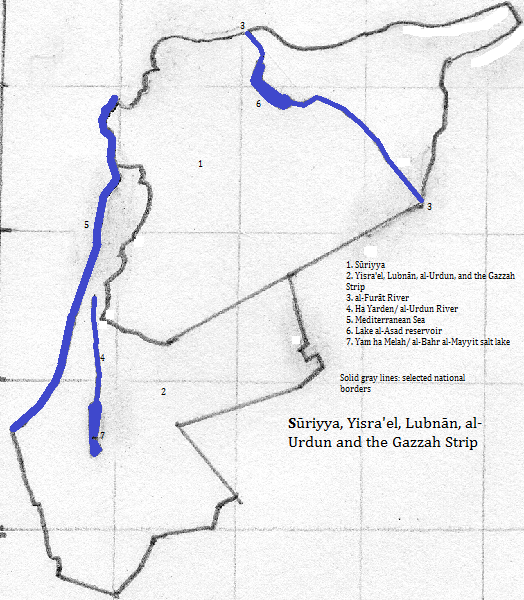
| To Duval Family Home Page | Asia | |
| To Chris Home Page | ||
| To Earth (Geography Home Page) |
Bordering the Mediterranean Sea is a narrow coastal plain. To its east are a series of north-south hills and mountains, highest in the north. Beyond this the land falls--deeply in the south to a Rift Valley that includes two salt lakes--less so in Lebanon where there is an intermontane plateau--and again more so in Sūriyya. Further east the land again rises, particularly in the south. Beyond these parallel features are four large zones. In Israel's far south is the Negev Desert; in Jordan and Sūriyya's east is the Syrian Desert which slopes down towards the Euphrates

Almost nine in ten speak Arabic, mostly using a dialect in the Syro-Lebano-Palestinian group, and most understand modern standard Arabic as well. Eight out of ten people are Moslems--six of ten Sunni, most of the rest Alawi Shi'ites. About 15% of the people are Jewish, almost all of them in Israel. The remainder are Christian, predominantly those at least nominally reconciled to the Roman Catholic Church.
See the Table of Syrian Cities and the Table of Israel, Lebanese, Jordanian and Palestinian cities. People leaving Africa arrived here first, so it's been inhabited by us for about 100,000 years. By 4,000 years ago Proto-Semitic had evolved from Afro-Asiastic and its speakers had passed through the area and settled in Arabia. Their descendents who moved back north spoke various languages including Eblaite, named after a city near Aleppo. Later languages include the Phoenician-Samaritan-Classical Hebrew dialect continuum, as well as Moabite and Aramaic, all as first languages, and Akkaidan Religion had three phases: pre-Christian, Christian and Moslem. Pre-Christian religion during historical times had several well known local religions, and some non-local imports such as Ishtar in the north and Hathor at Byblos. The best known local religion is Judaism, which evolved gradually from polytheist precursors to monotheism, and absorbed stories, laws, quotes and beliefs from other religions and texts. The gods, El, Baal, Yam and Mot, of ancient Judaism's chief rival, are no longer worshipped. The religion of the Kingdom of Israel when that was distinct from Judah was all but exterminated by the Christian Greeks. The sun worship once centered in Emesa is now only remembered from the futile efforts of one of its priests to impose it as the Roman imperial religion. The last local religion, that of the Essenes, was an offshoot of Judaism; some of their scripts found their way into Christianity.
In the second phase a Jewish or Essene prophet was eventually regarded as an incarnation of the new religionists' god. The religion, after many transformations outside the region, and after being adopted as the only allowed religion within the Roman Empire, imposed itself on the region, exterminating paganism Islam swept the region in its initial military expansion, converting by the full range of means from gentle to cruel, although not eliminating the Christians. Jews, dispersed throughout the former Roman and Parthian empires, began migrating back to Israel in the last century, especially when the nation won independence from Britain and survived the subsequent conquest attempt by neighboring states.
Israel, Jordan and Lebanon 1. Here, ישראל (Yisra'el or Israel) includes all of Yerusalayim/ al-Quds (Jerusalem) and the entire West Bank. The United Nations recognizes the State of Palestine, centered in al-Quds and the West Bank, and including the غزة (Ghazzah, Gazzah or Gaza) Strip. The غزة Strip is in fact independent of the Palestinian government that is centered outside of the strip. I am ignorant of whether the غزة Strip government calls itself the State of Palestine as does the West Bank government, so I just called it the غزة Strip for now. The West Bank area is not a de facto state based on 2013 conditions. While the Palestinian government has civil and police control over scattered areas, and civil-only control over other areas, ישראל (Yisra'el or Israel) has total control or police-only control over the rest. The West Bank is still de facto occupied notwitstanding the scattered partial or whole exceptions to Israeli control.Who was there before?
Around the Area
Sūriyya
Footnotes
2. Lubnan in conventional transliteration from Arabic; Liban in French.
3. al-Urdun in conventional transliteration from Arabic.
4. Suriyah in conventional transliteration from Arabic.
5. al-Furat in conventional transliteration from Arabic.
6. About one in twenty speak a dialect of Arabic spoken in eastern Egypt.
7. Or Ivrit in modern Hebrew.
8. Or Bayrut.
9. The western dialect is often called Assyrian.
10. Including those aetheist communists who are of Christian ancestry.
11. Paganism became a Christian term for the non-Judeo-Christian religions of the Roman Empire. It means religions of the country people, although many urban people also followed these religions.